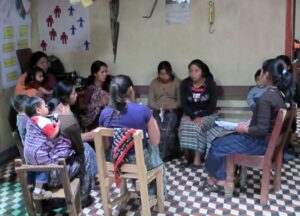In practice, community-based approaches to health typically use the following delivery methods:
- Routine systematic home visitation. Community health workers (CHWs) visit all homes in a geographic area on a routine basis, in order to provide education on healthy behaviors and when to seek care, and provide case management of childhood illnesses that kill the most children, including pneumonia, diarrhea, and malaria.
- Group meetings of community residents. CHWs, or other health care professionals, provide an educational and supportive environment to discuss healthy behaviors and when to seek care. For example, mothers groups use peer education and support to encourage healthy behaviors, such as breastfeeding. These groups also can track and identify health needs within a community.
- Outreach services provided on a routine basis at a service delivery point that is readily accessible to the surrounding population (e.g., mobile clinics). These are staffed by professional health care workers such as nurses and are particularly relevant in remote areas with sparse populations.
Reaching the most marginalized members of society with health services means breaking through barriers such as geography, culture, and poverty. This requires significant investment in human resources and organizational capacity. As a result, community-based approaches to health are not necessarily inexpensive.
However, community-based approaches are cost effective, providing great “bang for the buck,” or great health benefit for the cost. Community-level interventions are cost-effective even with delivery costs factored in, especially when several conditions are met (including strong supervision of community-level workers and integration of workers into teams supported by the larger health system).

Health economists can estimate the return (in health outcomes) on investment (cost) for a given intervention using cost-effectiveness analysis, which measures cost per disability-adjusted life year (DALY) averted. In other words, this analysis estimates the cost of using a particular intervention to prevent the loss of a year of healthy life. Many of the health interventions delivered via community-based approaches, such as treatment of malaria, provide health gains at less than $100 per DALY averted, which is considered highly cost effective.
Furthermore, focusing on the poorest communities in particular is a valuable investment: A 2017 report from UNICEF estimates that the number of lives saved per million dollars invested among the poorest children in the world is almost twice as high as the number saved by equivalent investments in better-off groups. This is because the poorest children around the world bear the disproportionate burden of preventable child death and disease because they lack access to essential health services.
Common Misconceptions about Cost of Supplies and Delivery
One important distinction to note here is the misconception that community-based approaches to health should be relatively inexpensive. Although the actual supplies may be, delivery is not: Proven interventions such as oral rehydration solution for diarrheal diseases, insecticide-treated bednets, and breastfeeding are examples of low-cost supplies or interventions. For example, a full course of oral rehydration solution—a simple treatment for diarrheal disease made of clean water, salt, and sugar—costs 25 cents or less for an infant, or could be made with household salt, sugar, and clean water. Similarly, a single dose of the measles, mumps, and rubella (MMR) vaccine can cost as little as 11 cents. And many practices, such as breastfeeding, have little to no market costs.
However, delivering proven tools and practices to those in need and motivating communities to use them requires financial investment and additional resources beyond the price of the commodities themselves. For example, a primary cost often covers training, paying salaries of, and supervising CHWs. A health worker needs to be trained and supervised to administer vaccinations and oral rehydration solutions. And, it takes time and money to train peer educators who can teach local mothers how to breastfeed.
It also takes additional resources to develop a health system to collect and analyze local data to ensure quality services and handle logistics, such as supply chains to get medications to communities in need. All of these costs can also vary based on each country’s cost of living, resources provided by the public sector (such as government workers and subsidized materials), and particular resource constraints in each setting.
Though public resources have been leveraged to implement community-based approaches to health, philanthropic funding is still needed to help the growing number of nonprofits who are providing on-the-ground services, in close partnership with local communities. In particular, philanthropic support can help nonprofits learn, scale, and extend health services to even more people. Philanthropy can also help strengthen the policies and systems in which nonprofits work, and foster ongoing research and innovation in community health.
